Pickled fruit
Pickled fruit refers to fruit that has been pickled.[1] Pickling is the process of food preservation by either anaerobic fermentation in brine or immersion in vinegar. Many types of fruit are pickled.[1] Some examples includes tae,igit,buni, apples, crab apple, pears, plums, grapes, currant, tomato and olives.[1][2] Vinegar may also be prepared from fruit,[2] such as apple cider vinegar.
Peaches
.jpg)
Pickled peaches may be prepared from medium-sized, non-melting clingstone peaches that are small-seeded.[1] In the United States prior to around 1960, some were prepared from small, unripe freestone peaches.[1] They may be prepared with sugar, cinnamon, cloves and allspice to add flavor. Pickled peaches may be used to accompany meats and in salads,[3] and also have other uses.
Pears
.jpg)
Pickled pears may be prepared with sugar, cinnamon, cloves and allspice to add flavor, and may be referred to as spiced pears.[1] They may be prepared from underripe pears.[4] Pickled pears may be used to accompany dishes such as roasts and salads,[5] among others.
List of pickled fruits
- Apple [6]
- Apricot [6]
- Barberry [6]
- Blackberry [6]
- Blueberry [8]
- Caper [9]
- Cherry [6]
- Citrus peel [8]
- Currant [1]
- Dates [6]
- Damson [6]
- Fig [8]
- Grape [1]
- Mango pickle [2]
- Nata de coco – fermented fruit juice[2]
- Nata de pina – fermented fruit juice[2]
- Olives [1][10]
- Orange [3]
- Peach [1]
- Pear [1]
- Peppadew
- Pickled lime [2]
- Pickled pepper
- Plum [1]
- Preserved lemon [2]
- Prunes [11]
- Strawberry [8]
- Tomato [1]
- Watermelon may be pickled, as well as watermelon rind.[12][13][14]
Gallery
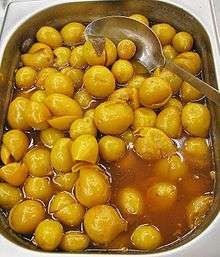
 Pickled watermelon.
Pickled watermelon. Buai khem is Thai for "salted (Chinese) plums". They are prepared from Prunus mume (also known as "Chinese Plum" or "Japanese Apricot"), and are pickled, dried, and salted.
Buai khem is Thai for "salted (Chinese) plums". They are prepared from Prunus mume (also known as "Chinese Plum" or "Japanese Apricot"), and are pickled, dried, and salted.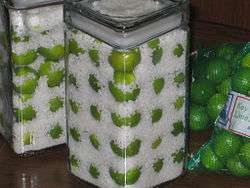 Chanh muối, a type of pickled lime, aging in glass containers
Chanh muối, a type of pickled lime, aging in glass containers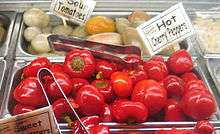 Pickled pimientos
Pickled pimientos Olives being pickled
Olives being pickled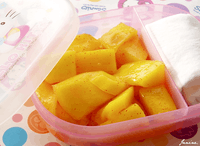
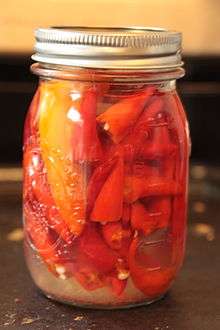 Jarred pickled peppers
Jarred pickled peppers Pickled tomatoes
Pickled tomatoes
 Pickled apple along with other veggies.
Pickled apple along with other veggies.
By country
In Malaysia, some fruits are pickled when they are unripe, such as belimbing, kedondong, chermai,[15] lime, pineapple, papaya, mango and nutmeg.[16]
See also
References
| Wikimedia Commons has media related to Pickled fruit. |
- 1 2 3 4 5 6 7 8 9 10 11 12 13 Woodroof, J.G.; Luh, B.S. (1986). Commercial Fruit Processing. Springer Netherlands. pp. 521–. ISBN 978-94-011-7385-8.
- 1 2 3 4 5 6 7 Battcock, M.; Azam-Ali, Sue (1998). Fermented Fruits and Vegetables: A Global Perspective. FAO agricultural services bulletin. Food and Agriculture Organization of the United Nations. p. 14. ISBN 978-92-5-104226-7.
- 1 2 Carrolata, K. (2012). Pickled: From Curing Lemons to Fermenting Cabbage, the Gourmand's Ultimate Guide to the World of Pickling. Adams Media. pp. 86–87. ISBN 978-1-4405-3873-5.
- ↑ Chesman, A. (2012). The Pickled Pantry: From Apples to Zucchini, 150 Recipes for Pickles, Relishes, Chutneys & More. Storey Publishing, LLC. p. 109. ISBN 978-1-60342-890-3.
- ↑ Hobson, J.; Watts, P. (2012). Making Traditional and Modern Chutneys, Pickles and Relishes: A Comprehensive Guide. Crowood Press, Limited. p. 119. ISBN 978-1-84797-502-7.
- 1 2 3 4 5 6 7 8 Home Pickling. Culinary arts. Taylor & Francis. 2014. ISBN 978-1-317-84643-7.
- ↑ Tsuji, S. (2007). Japanese Cooking: A Simple Art. Cookery, Food and Drink Series. Kodansha International Limited. p. 317. ISBN 978-4-7700-3049-8.
- 1 2 3 4 McCarthy, L. (2012). Jam On: The Craft of Canning Fruit. Penguin Publishing Group. pp. 163–. ISBN 978-1-101-57516-1.
- ↑ Carrolata, K. (2012). Pickled: From curing lemons to fermenting cabbage, the gourmand's ultimate guide to the world of pickling. F+W Media. p. 41. ISBN 978-1-4405-4023-3.
- ↑ California Fruit News. Howard C. Rowley. 1921. p. 3.
- 1 2 Grigson, J.; Skargon, Y.; Hill, J.; Dickerman, S. (2007). Jane Grigson's Fruit Book. At table series. University of Nebraska Press. p. 449. ISBN 978-0-8032-5993-5.
- ↑ Ziedrich, L.; Williams, C. (2009). The Joy of Pickling: 250 Flavor-packed Recipes for Vegetables and More from Garden Or Market. Harvard Common Press. p. 287. ISBN 978-1-55832-375-9.
- ↑ Andrea, A.L. (1918). Home Canning, Drying and Preserving. Doubleday, Page. p. 107.
- ↑ White, A.; Varney, J. (2012). Philadelphia Chef's Table: Extraordinary Recipes from the City of Brotherly Love. Chef's Table. Lyons Press. p. 147. ISBN 978-0-7627-8944-3.
- ↑ Janick, J.; Paull, R.E. (2008). The Encyclopedia of Fruit and Nuts. CABI Publishing Series. CABI North American Office. p. 373. ISBN 978-0-85199-638-7.
- ↑ Steinkraus, K. (1995). Handbook of Indigenous Fermented Foods, Second Edition, Revised and Expanded. Food Science and Technology. Taylor & Francis. p. 139. ISBN 978-0-8247-9352-4.
